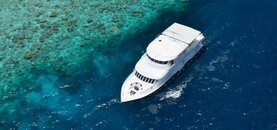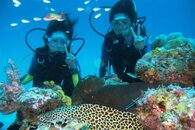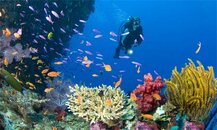
Diving In Maldives
The Maldives has become one of the world’s premier scuba diving destinations, because of the abundance of amazing white sand beaches, coral reefs, clear warm waters, numerous scuba diving sites and rich marine life.
…but it's the abundance of marine life that really sets the Maldives apart; the atolls offer excellent reef diving, much of it done at a leisurely drift pace. The Indian Monsoon Current sweeps along the island chains, moving nutrients – and sometimes divers – along. Deep, nutrient rich water flows up along the walls, feeding the sponges and soft corals clinging to the rock sides. Inside the atoll lagoons, rock pinnacles – thila – vault up from the bottom to scratch the water’s surface. In the channels, divers explore swim-throughs, caverns and overhangs festooned with colorful sponges, invertebrates and gorgonians. At well-known cleaning stations, wrasse and shrimp service manta rays, and other large marine species.
Divers prepare to dive into the Maldives frequented by the jet-setting crowd and those looking for a superior dive experience, more divers are clamoring for a glimpse at some of the planet’s most pristine reefs and the amazing cast of supporting aquatic characters, big and small. A welcoming culture and some of the finest live-aboard dive boats and luxury resorts on the globe, make for an unforgettable dive vacation.
Dive Schools
All the resorts in the Maldives have dive schools on them. Of course the facilities, equipment and the staff differ from resort to resort, depending on its size, its location and clientele. However all the resorts offer beginners’ dive courses and a variety of other courses towards PADI certification. In almost all the resorts instruction is available in English and German, however many resorts offer instruction in Italian, French, Japanese and a host of other European languages too. While some dive schools are Instructor Development Centers (IDCs), others too offer a wide variety of advanced and specialized dive courses. It is advisable to check up on the languages of instruction and courses available, before you book at a resort for your diving holiday. Equipment wise, all have the basics - compressors, tanks, BCDs, wetsuits, weights and weight belts and can provide a limited number of other accessories such as lamps and dive computers. Only some dive schools rent out underwater cameras and video cameras. Dive schools at all the resorts conduct daily dive boat trips to dive sites around the island, throughout the year. However, bigger schools offer a variety of trips everyday to different dive sites. In these resorts, the advanced diver would have choice of dives daily, to choose from. Night dives and other specialized dives are not conducted on a daily basis at all the resorts. However on the more specialized dive resorts, these too are available. The same goes for night diving in the resort’s house reef. The dive schools in all the resorts invariably consist of one or more classrooms - air-conditioned at some, wet room and storage space for the school’s as well as private equipment. Some of the bigger schools also have dive shops and video processing facilities.
Dive Equipment
Resorts and live-aboards in the Maldives provide high quality and often the latest in diving equipment. All resort dive schools and live-aboard diving dhonis are equipped with compressors, tanks, regulators with octopus, BCDs, masks, fins and snorkels and other equipment such as dive computers, wetsuits, weights and weight belts. The equipment is well maintained and stringent safety checks are regularly made. You may bring your own mask, fins and snorkel. If you wish to bring your own wetsuit a 3 mm full-length wetsuit or lycra suit is perfect for any time of the year. However some prefer a 5 mm wetsuit when doing more than one dive a day. Ocean temperatures rarely vary beyond 27 - 30 degrees Celsius. During hot periods water temperatures inside the lagoon increase measurably, and most divers are comfortable without a wetsuit during this period.
Note that under Maldivian diving laws all divers must have octopus regulators. Carry some spares just in case of a breakdown or shortage.
Currents
The Maldivian archipelago is swept by ceaseless currents caused by the monsoons; generally east to west during the northeast monsoon, from December to April and west to east during the southwest monsoon, from May to November. However this is not a hard and fast rule, as changes in wind directions and tides can offset the influence of the oceanic currents - especially so during the transitional period between the two seasons. Further, the location of islands reefs and ‘thilas’ cause great irregularity in the flow of current streams inside atoll passes. Many local boat captains show great skill in telling the direction of the current by observing tiny ripples or wave patterns on the surface. However, the dive guide often jumps into the water to determine the exact strength and direction.
Strong currents often make a dive site livelier, and that makes the additional effort worthwhile.
To enhance the enjoyment and safety of a dive, consideration of the direction and strength of currents is extremely important, wherever you are diving; whether it is in the ‘kandu’, a pass between the atoll reefs or ‘thila’ a shoal, inside the atolls. The success of a dive almost always depends on these variables.

Underwater photography
Many underwater photographers agree that Maldives is the best place in the world to photograph fish. Mainly because nowhere else is there such form and variety of fish and coral life. The best dive sites for photographing large pelagic fish such as sharks, mantas or jacks are the atoll passes or channels. Currents are often strong in the channels and it may become necessary to hold on to something to remain still. For good images of colorful fish and corals, dive in the ‘thilas’ or shoals inside the atolls. The conditions in these often are suitable for you to calmly and carefully frame your shots. While UW cameras are available for rent at most dive schools in the Maldives, you may not be able to get the exact equipment you require.
- Keep your camera still when shooting
- Shoot from the reef bottom whenever possible.
- Squeeze the shutter, don’t punch it.
- Exhale just before you shoot.
- Keep your arms in, stabilize your elbows against your body.
- Maintain slightly negative buoyancy if there is a surge.
- In midwater, control your buoyancy with breathing only.
- The easy recipe for holiday photographers
- Use ISO 100
- Set the camera to ‘A’ (Nikonos) or ‘Aperture priority’ (SLR)
- Set the strobe on TTL
- Set an aperture of:
- o f/11 between the surface to 10 m (33 ft)
- o f/8 between 10 and 20 m (33 and 65 ft)
- o f/5.6 or f/4 in water deeper than 20 m (65 ft)
- Nikonos: preset focus for 90 cm (3 ft), with either a 35 mm or 28 mm lens and stay between that and 1.2 m (4 ft) away from the subject.
- SLR: Prefocus 50mm lens for 90 cm (3 ft) and get this distance from your subject, then fine-tune focus. Compose and shoot.
- Maintenance of photographic equipment
- Thoroughly rinse all equipment after each dive.
- Leave them in fresh water for a few minutes if possible.
- Spray an anti-saline liquid over all parts in order to eliminate traces of salt crystals.
- Check all accessible O-rings at least once a day, carefully clean their seating and gently lubricate them to keep them soft and elastic.
- Get your equipment checked by a specialist at least once a year

Protected Marine Areas
Steps have been taken to avoid over-exploitation of natural resources. Protected Marine Areas were established in 1995. This was the first step in protecting these areas from the detrimental effects of over-fishing, coral mining, anchor damage and rubbish. The killing of turtles, which is under threat of extinction, is banned and the export of turtle shells and products made of turtle shell is prohibited. Sport fishing practiced by some islands is now confined to the tag and release method



